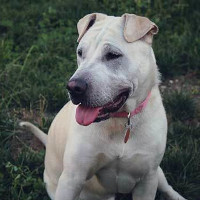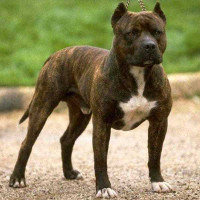Appearance of the Shar-Pei Pitbull Terrier
|
| The Shar-Pei Pitbull Terrier is a hybrid of the Shar Pei and the American Pit Bull Terrier and, as such, may inherit appearance traits from one or both parent breeds. Breeders and owners of this hybrid describe it as having a stocky, heavy body, but small, compact and even delicate feet. With a shoulder height of 43 to 53 centimeters and a weight of 13.5 to 27 kilos, this medium to large-sized dog possesses amazing strength and power, which comes mainly from the American Pitbull parent. The Shar Pei parent brings dark eyes, a dark muzzle and wrinkled skin to the biological mix. Both parents contribute to a short to medium coat that is fine and straight. The colors available for your hybrid's coat are: black, red, fawn, sable, blue, cream, brown, gray, brindle and black and white. Your hybrid may have lighter eyes, especially if its color is diluted, with a nose that can be any color depending on coat color, and ears that can be small, triangular and erect, sitting high and close to the head. Its tail can be more or less long, set high or low, and may or may not curl over its back, depending on which parental breed has the most influence in the biological mix. It may have a black or blue tongue. |
Temperament of the Shar-Pei Pitbull Terrier
|
| Your Shar-Pei Pitbull Terrier is a hybrid of the Shar Pei and the American Pit Bull Terrier. As a mixed breed, your hybrid may inherit temperament and personality traits from either or both parent breeds. Breeders and owners of this hybrid describe it as loyal and affectionate, yet sometimes quite independent. This independence leads to dominance, making it vital for the owner or handler to firmly establish, at a very young age, who is the leader, otherwise there will be a lifelong competition for this position between owner/handler and dog. Because of his strong will and independence, it will be vital that he is properly socialized from an early age to ensure that he will be affectionate, gentle, friendly, social, cheerful and protective. If properly socialized from an early age, he'll probably get along with children and other animals, but he'll probably be wary of strangers. He's fairly intelligent, so with the exception of those periods of independence, he should be fairly easy to train, using positive training and encouragement methods. He's an active dog who can develop really annoying destructive habits if bored. |
Needs and activities of the Shar-Pei Pitbull Terrier
|
| Your Shar-Pei Pitbull Terrier hybrid is an active dog, requiring 1 to 2 hours of exercise a day without exception. This exercise can take the form of long walks or jogs, playing in a dog park or fenced yard, interactive games like fetch, frisbee, fly ball, earth dog training, obedience training and pulling activities. This hybrid can be a barker, so this should be taken into account for those living in apartments, condominiums or other noise-restricted areas. Because of its size and energy level, it is best suited to large family homes with fenced yards, but can adapt to apartment or condominium living, provided appropriate exercise opportunities are available and utilized. It can tolerate hot and cold temperatures in both rural and urban environments, provided extra precautions and protection are taken when these temperatures become extreme. |
Maintenance of the Shar-Pei Pitbull Terrier
|
| Your Shar-Pei Pitbull Terrier hybrid falls into the low-maintenance category, with a small to moderate amount of shedding possible, especially during normal shedding seasons. Its coat is not considered hypoallergenic and will need weekly brushing, except during normal seasonal shedding periods, when it will probably need daily brushing to remove debris and loose hair. It will also need to be vacuumed frequently during these seasonal moulting periods. It is considered low in the drool category and low to moderate in the odor category, as it needs special attention to regularly wipe/dry folds to avoid fungal infections. He is prone to ear infections, which makes a weekly check-up of the ears vital, cleaning them if necessary with absorbent cotton and a cleaning product approved for canine ears, to maintain ear health. As with all dogs, dental health is also important. He should have his teeth brushed at home two or three times a week to prevent the development of periodontal disease and the tooth loss that goes with it. |









 English (United Kingdom)
English (United Kingdom)